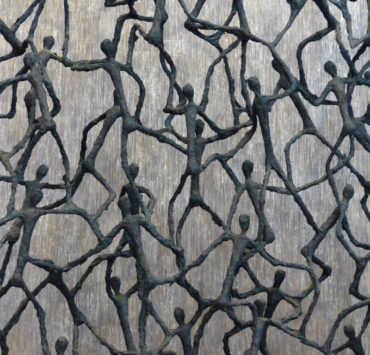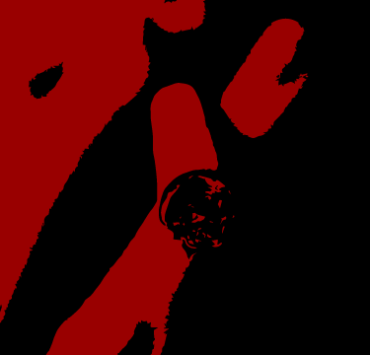
When I was a teenager in Los Angeles, I nearly worshipped Frida Kahlo. My mom would sometimes take me downtown to Olvera Street, the oldest part of the city, where you can still tour the longest-surviving residence in Los Angeles, built in 1818 and now surrounded by old buildings housing Mexican restaurants with outdoor seating and mariachi bands, and shops selling embroidered blouses and Mexican art—the whole street a memorial to some romanticized image of old Mexico. On Olvera Street I saw and collected my first Frida Kahlo relics—her self portraits displayed in brightly-colored frames, earrings featuring the artist’s face, tin ornaments or charms, which I’ve heard called milagros, bearing Frida’s image. Later as a secretary in Queens, I would paper my cubicle with Frida’s visage, and years later, the pictures still line one curved wall of my Pittsburgh apartment’s turret; Frida’s formidable black eyes peer at me from magnets on my refrigerator, the calendar near my desk. So I feel a pang of recognition when the speaker of Yona Harvey’s “Turquoise” remarks,
These days, Frida Kahlo appears
like a god to whom I’ve prayed,
like accessories that shake
at the bottom of a woman’s shopping bag, a loose
divinity of feel-good postcards & magnets
rocking on paper handles in the crease of an upright arm.
But Kahlo’s deification masks a more complex reality. Later in the poem, Harvey writes,
Who’s Lupe, Who’s Frida, Who’s Diego? I can’t help but conclude
someone’s at work on a grand cliché I’m supposed to buy into
& there’s nothing harmless about Frida Kahlo, exquisite painter
of stitches & steel, thorns & wombs & vaginas—something utterly
misleading about Frida’s face on a 4×4 note card, a little
too neat & too square, which makes sense in the American sense
of matinee love or lust or art or what passes for art, or living
the life of an artist, those heroes & heroines dangling over
the cliffs of vanity, begging for a little more rope.
Kahlo’s co-option by makers of “feel-good postcards & magnets” renders the painter’s life and work less disarming, less dangerous, less threatening to the status quo. Kahlo has been molded into a “grand cliché” of artistic-narcissistic tragedy, a commodity canned for matinee consumption. While I was writing this review, a credit card ad appeared on my Facebook feed to drive home the point. Now a Fridamaniac can own a VISA card featuring Kahlo’s image, an appropriation I doubt the Communist artist would support. I’m reminded of an instructor who told our graduate workshop that she preferred for the world of contemporary poetry to be small and insular. “Think about what happens when poetry becomes commercial,” she said. “Sylvia Plath’s work is interesting and nuanced but they’ve turned her into this post-adolescent depressive cliché”—or something to that effect. But Harvey probes deeper still. If, as her speaker claims, “wearing turquoise jewelry & Frida Kahlo skirts/ doesn’t make women artists,” what does it mean to be an artist in general and a woman artist in particular? How can we escape the grand cliché, or how can we subvert it?
Harvey’s challenge comes at a particularly charged moment. For the three years that VIDA has been tracking the number of women writers published and reviewed by leading magazines, it has found that we are grossly underrepresented, and statistics for writers of color are at least as abysmal. Roxane Gay of The Rumpus found that in 2011 nearly 90% of the books reviewed by The New York Times were the work of white writers, and about twice as many were written by men as by women.
Of course, sexism in the literary world isn’t a new problem. In a 2010 blog post marking International Women’s Day, the poet Ron Silliman recalls how as late as the 1960s, the indomitable “Gertrude Stein was still considered a joke as a writer, an extra-literary phenomenon of those crazy between-war years in Paris.” In a move reminiscent of Stein’s Tender Buttons, Hemming the Water concerns itself with decidedly nondramatic domestic trappings traditionally associated with women—scarves, girdles, and, as the title suggests, sewing—as stitching, hemming, and thimbles reoccur throughout the book. In “Thumbelina, I Wrote a Song About You,” the image of a fearless and efficient heroine emerges:
The Great Machine, You keep it oiled
Not much room between the stitches
Cut it
Pin it
Toss it
Hang
Walk big
Walk wide
When it rain
Anna Julia
Mary Church
Always ghosting in the sound
The ghosts Thumbelina hears are important foremothers. Anna Julia Cooper was a former slave who rose to become a prominent scholar, among the first African-American women to earn a Ph.D., while Mary Church Terrell was one of the first awarded a Bachelor’s degree—she went on to become an activist for civil rights and women’s suffrage. In “Thumbelina,” the woman who threads the bobbin, oiling “The Great Machine,” also fights for wages and sleeps with a pistol near her head. But garment worker activism is as much the stuff of matinee nostalgia as Frida Kahlo’s injuries, troubled marriage, and agonized art. Just as Olvera Street survives to celebrate some romantic vision of Old Mexico, Manhattan’s Lower East Side Tenement Museum stands amidst boutiques and luxury bakeries to mark a more “authentic” hardscrabble past of garment workers and pushcart vendors, even as skyrocketing rents chase their contemporary counterparts farther and farther from the city’s core. The grand cliché wears many faces. But when stitching reappears in “Sound—Part 3 (Ostinato): All the World’s Wars Commence in My Head,” the troubled voice of the speaker complicates Thumbelina’s superhero certainty.
Hunched in a thimble, I wept. Yes, yes.
Won’t make no apologies. Naw, Sir.
Who will take this burden?
Ought not walk alone.
Said—
Ought not walk alone.
As the repetition creates a call-and-response, half-singing quality, the speaker is caught in a web of limitations and unspoken dangers. “Words can make a mountain./ No pulpits in the thimble,” she asserts. Sewing is not a platform after all. Power comes only when stitching becomes speech. Or when speech becomes song.
Kahlo, Terrell and Cooper are not the only heroes of this book. Towering above them all is the influence of Mary Lou Williams. Williams was a jazz pianist who composed for the likes of Duke Ellington and Benny Goodman and mentored a string of famous male musicians—including Thelonius Monk, Charlie Parker, Miles Davis, and Dizzy Gillespie. Responding to a first-book questionnaire in The Volta, Harvey describes Williams as her (and the collection’s) anchor. But compared to Kahlo’s status as a cult icon, Williams remains a relatively obscure figure and has therefore escaped the “grand cliché” for the dubious status of the undersung. In “Communion with Mary Lou Williams,” Harvey’s speaker addresses the musician:
Dear Composer, Dear Mother, Dear Daughter of the Elusive, Dear Black Coffee, Dear Ambition, Dear Confidence, Dear Zoning, Dear Doubt, Dear Absence, Dear Comeback, Dear Plays Like A Man, Dear Chez Mary Lou, Dear Daring, Dear Rosary in the Palm, Dear Twelve Bars over Dishes Clanking, Dear Muse, Dear Majesty, Dear Live at the Cookery, Dear Sinner in Search of a Saint, Dear Suckled Breast, Dear Ornery, Dear Ornate, Dear Obstacle, Dear Orchid, Dear Ostrich Feather in a Cap, Dear Thrift Store Owner, Dear Shoes from Lucille Armstrong, Dear Mink Bowtie from Ellington, Dear Matron of Music, Dear Soup for Musicians, Dear Holy Spirit, Dear Glory, Dear Daughter of the Imperfect Mother,
Harvey’s Williams is a composer, dishwasher, and muse—addressed as “ornery” even while seated at the left hand of the Father. She is a “Suckled Breast” who “plays like a man,” a “Thrift Store Owner” whose own wardrobe includes gifts from her friends and famous colleagues. As Stephanie Mencimer says in her Washington Monthly article on Kahlo, it “may be that real progress has come when a woman can be remembered both as a great artist and as a despicable cur.” While Harvey’s Williams is no cur, she is multifaceted, and like Williams, the speaker of these poems occupies a variety of roles—mother, daughter, wife, teacher, reader, music lover, thrift-store shopper, childhood wearer of too-small shoes, someone both at home and at odds with the religiosity of her upbringing. One way to escape the grand cliché is to defy fixation to any one image or representation.
Harvey’s fascination with Williams underscores her own sense of musicality in language. In “Devil Music,” one of the book’s most haunting poems, the Devil plagues the dreams of an expectant mother:
You always tune me out, he says.
Like when I play Dylan for you.
You never listen when I play Dylan for you.
& that’s his trick, his truth & lie. His accusation & his whine.
His decent taste in music. It’s true sometimes, a sound
won’t fit, the voice, the pitch, too scratchy, too low.
A slippery tension emerges between content and form—as the slant-rhymed, sleepily repetitive lullaby nurses the sinister story it bears. Remember, the devil’s deception is an aural one. With his “decent taste in music” the devil as perpetrator is frighteningly difficult to place.
This shiftiness is Harvey’s particular genius. In poems that weave tenderness and violence, the expectation and the surprise, Harvey thwarts the grand cliché even as she courts it, stitching together a polyphony of voices, visions and songs in a patchwork too slippery for any matinee idol to wear.

Lauren Russell is the author of Descent (Tarpaulin Sky Press, 2020) and What’s Hanging on the Hush (Ahsahta Press, 2017). A 2017 NEA Creative Writing Fellow in Poetry, she has also received fellowships from Cave Canem and the Wisconsin Institute for Creative Writing and residencies from the Rose O’Neill Literary House at Washington College, the Millay Colony for the Arts, and City of Asylum/Passa Porta. Her work has appeared in The New York Times Magazine, the Academy of American Poets’ Poem-a-Day, The Brooklyn Rail, Cream City Review, and the anthologies Bettering American Poetry 2015 and Furious Flower: Seeding the Future of African American Poetry, among others. She has been assistant director of the Center for African American Poetry and Poetics at the University of Pittsburgh for the last four years. Beginning in the fall of 2020, she will join the faculty of Michigan State University as an assistant professor in the Residential College in the Arts and Humanities and director of the Center for Poetry there.







